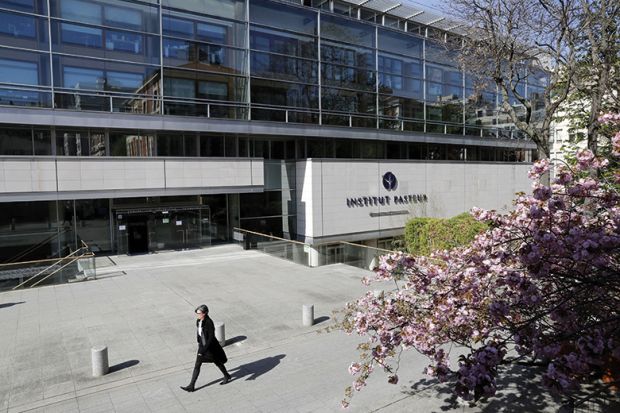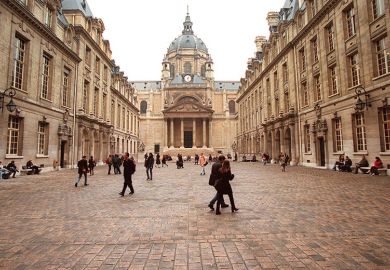Tourists wandering through Paris’ historic 5th arrondissement seldom stop to examine the gatehouse of École Normale Supérieure, one of France’s most elite learning establishments.
With the vast domed Panthéon down the street and the famous Jardin du Luxembourg so close, why would anyone take a selfie next to an unremarkable edifice inhabited by a few security guards? The plain building deserves many more admirers, however, because it was where the invention of several vaccines cleared the way for the development of modern preventative medicine.
Inside the gatehouse’s attic, the school’s director of scientific studies Louis Pasteur established a small laboratory in 1857 – later expanded to the adjoining pavilion – where he would revolutionise medicine with discoveries that saved millions of lives across the world. When news broke that Pasteur’s vaccines for rabies and anthrax had been successfully trialled, it caused a sensation.
“People queued outside in the street for his vaccines,” explained Marc Mézard, director of ENS, the equivalent position to that held by Pasteur 160 years earlier.
“As director of studies, he was quite tough and had lots of arguments with students,” joked Professor Mézard, who is amused that Pasteur’s student discipline ledger shows that the father of immunology would impose fines on unruly undergraduates caught smoking in class.
Pasteur could not remain in his humble laboratories for very long after his success; his research moved in 1887 to a specially built Institut Pasteur, where scientists from different disciplines worked side by side with the goal of preventing and curing disease. This organisation now has about 23,000 employees in its global network of research centres and a €330 million (£296 million) annual budget.
However, Paris’ early pioneering of university technology transfer has long been overtaken by other more successful examples of scientific spin-outs, such as Hewlett-Packard, Google and other multinational corporate giants created by Stanford University whizz-kids. Indeed, hundreds of science parks now rely heavily on the intellectual capital of top-ranking universities – including the new Paris-Saclay cluster of high-tech businesses and higher education institutions south of the capital, which will receive about €7.5 billion in funding for an endowment, buildings and transport links.
While Paris’ Latin Quarter has unsurprisingly failed to keep up with Silicon Valley or other global hubs dedicated to turning scientific ideas into billion-dollar products, this might be about to change. With the Institut Curie, a cancer research centre employing 3,400 staff, the Institut Pasteur and several other leading research centres dotted around the historic district, it remains an important scientific hub. Recent university reforms and additional funding may now help to turn some of the high-end research produced here into profitable companies – an ambition backed heartily by President Emmanuel Macron, who sees tech innovation as central to his vision for France as a “start-up nation”.
As part of reforms initiated by former president Nicolas Sarkozy in 2011, several leading research institutions, including ENS, Institut Pasteur, Institut Curie and Chimie ParisTech, numerous grandes écoles and conservatoires, and Paris Dauphine University have joined a federation of 22 institutions known as Paris Sciences et Lettres University, otherwise known as PSL University.
One of the more tangible products of this Parisian alliance is the Institut Pierre-Gilles de Gennes (IPGG), a €27.4 million laboratory completed in 2015 and named after the charismatic Nobel prizewinning physicist – pictured, pipe in hand, in its lobby – who died in 2007. Some €15.2 million came from additional funds related to reforms, while another €12 million arrived from the Paris mayoralty.
Located in a former university administration building, the institute houses 15 separate research teams from various PSL members investigating microfluids – a field of study that allows drugs to be fed one cell at a time into the human body, potentially transforming drug treatment in the future.
Bringing together the physicists, engineers, biologists and chemists needed to conduct research at this nano-level has been a game-changer, said Stéphanie Descroix, director of the research team looking at macromolecules and microsystems in biology and medicine.
“When we were all in different buildings across Paris, interaction with other teams was difficult – now we are truly neighbours,” said Dr Descroix. “If I want to understand something about physics, I can spend two hours with a physicist who is on a different floor.”
Having experts in technology start-ups has also been crucial for starting conversations about when research might be ready for the commercial market, said Dr Descroix.
“The tech start-up team is not too far [away], so we can have normal interaction with them – it’s very easy to talk to them,” she added.
With additional funding arriving from the PSL alliance, many of the world’s top young researchers in microfluids are now based at the institute, said Matthieu Piel, another team leader looking at immunity in dendritic cells.
“Half of my team doesn’t speak a word of French,” said Dr Piel, whose researchers hail from Russia, India, Chile and China, among other nations. France’s tradition of having engineers and physicists in biology laboratories is now starting to pay off, given the level of sophistication in the tools required in microfluids research, he added.
Creating this type of dynamic interdisciplinary research environment is the primary benefit of the PSL alliance, said Patrick Tabeling, the IPPG’s director, who explained that gene sequencing and related bespoke medicines of the future are dependent on advances in microfluids.
“This major project could never have happened without PSL, but this is about more than just receiving additional money,” said Professor Tabeling, adding that it is “unique to have this complementary group of people working together.”
PSL is now attempting to accelerate its technology transfer push by working with the venture capital firms Elaia and Auriga to create the PSL Innovation Fund, which will support student and staff start-ups.
Back in Pasteur’s former office at ENS, Professor Mézard – who stepped down recently as interim PSL president and has been succeeded by Alain Fuchs, the former president of France’s main research body, the National Centre for Scientific Research – said that the IPGG was a good example of where PSL is more than the sum of its parts.
“Bringing together these institutes on a cross-disciplinary project has completely changed the way they work,” said Professor Mézard, citing a recently formed gene sequencing company as an example of a “high-tech company with basic research at its core”.
Investing in this type of research in this way is typical of Pasteur, who himself grew wealthy on the back of his scientific prowess, added Professor Mézard.
“It is high-risk and high-stakes investment, but there are also potentially very high returns.”
Register to continue
Why register?
- Registration is free and only takes a moment
- Once registered, you can read 3 articles a month
- Sign up for our newsletter
Subscribe
Or subscribe for unlimited access to:
- Unlimited access to news, views, insights & reviews
- Digital editions
- Digital access to THE’s university and college rankings analysis
Already registered or a current subscriber?









